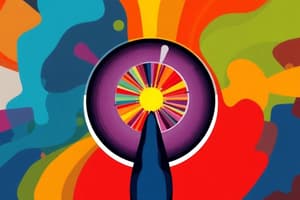Podcast
Questions and Answers
What was the significance of Isidor Rabi's Nobel Prize in 1944?
What was the significance of Isidor Rabi's Nobel Prize in 1944?
- He demonstrated how linear magnetic field gradients could be used to localize NMR signal.
- His work helped in understanding the magnetic moments of nuclei, providing insights into their properties. (correct)
- He developed zeugmatography, a method that relied on the effects of two magnetic fields to produce two-dimensional tomographic images.
- He produced the first diagnostic MR images, cross-sectional images of a human thorax.
What method did Peter Mansfield pioneer in 1973 that enabled slice-by-slice signal localization in NMR?
What method did Peter Mansfield pioneer in 1973 that enabled slice-by-slice signal localization in NMR?
- Back-projecting data to form 2-dimensional tomographic images.
- Using a combination of spectroscopy and tomography.
- Employing two magnetic fields to create zeugmatography.
- Using a linear magnetic field gradient. (correct)
What was the subject used in Lauterbur's first crude images?
What was the subject used in Lauterbur's first crude images?
- A solid piece of camphor.
- Larry Minkoff's chest.
- A tiny clam. (correct)
- A human thorax.
What was the primary breakthrough achieved by Felix Bloch and Edward Purcell in 1946?
What was the primary breakthrough achieved by Felix Bloch and Edward Purcell in 1946?
What was the breakthrough achievement made by Raymond Damadian in 1977?
What was the breakthrough achievement made by Raymond Damadian in 1977?
What is the significance of 'resonance' in the term 'Nuclear Magnetic Resonance'?
What is the significance of 'resonance' in the term 'Nuclear Magnetic Resonance'?
What was the duration for obtaining the first whole-body image using Damadian's method in 1977?
What was the duration for obtaining the first whole-body image using Damadian's method in 1977?
What did Damadian call his imaging method?
What did Damadian call his imaging method?
What was the key contribution by Jean Baptiste Joseph Fourier to the field of Magnetic Resonance Imaging?
What was the key contribution by Jean Baptiste Joseph Fourier to the field of Magnetic Resonance Imaging?
What was the subject of the first human head MRI scan produced by Damadian in 1978?
What was the subject of the first human head MRI scan produced by Damadian in 1978?
Which scientist published the first NMR signals from a living animal?
Which scientist published the first NMR signals from a living animal?
What significant finding did Raymond Damadian report in 1971?
What significant finding did Raymond Damadian report in 1971?
What was the primary contribution of Raymond Damadian's US patent filed in 1972?
What was the primary contribution of Raymond Damadian's US patent filed in 1972?
What is MRI technology primarily used for?
What is MRI technology primarily used for?
What is the main advantage of MRI over X-rays, CT scans, and ultrasounds?
What is the main advantage of MRI over X-rays, CT scans, and ultrasounds?
Which of the following is NOT a key component in the function of an MRI scanner?
Which of the following is NOT a key component in the function of an MRI scanner?
What was the name of Damadian's first prototype MRI scanner?
What was the name of Damadian's first prototype MRI scanner?
Which year did Damadian produce the first commercial MRI scanner?
Which year did Damadian produce the first commercial MRI scanner?
Who invented the use of Fourier transform of phase and frequency encoding to reconstruct 2D images?
Who invented the use of Fourier transform of phase and frequency encoding to reconstruct 2D images?
What did Damadian's patent application focus on?
What did Damadian's patent application focus on?
What company did Damadian found to manufacture MRI scanners?
What company did Damadian found to manufacture MRI scanners?
Which of the following methods was initially used by Damadian but later abandoned?
Which of the following methods was initially used by Damadian but later abandoned?
What was the motivation behind Damadian's research on NMR?
What was the motivation behind Damadian's research on NMR?
What did Damadian's team achieve in 1975?
What did Damadian's team achieve in 1975?
What significant discovery did Nikola Tesla make?
What significant discovery did Nikola Tesla make?
What is the main principle behind Damadian's NMR findings for detecting tumors?
What is the main principle behind Damadian's NMR findings for detecting tumors?
What was the primary difference in NMR signal relaxation times observed between tumors and normal tissues?
What was the primary difference in NMR signal relaxation times observed between tumors and normal tissues?
What type of image did Lauterbur produce in his groundbreaking experiment?
What type of image did Lauterbur produce in his groundbreaking experiment?
What was the key element that Lauterbur used to generate the image?
What was the key element that Lauterbur used to generate the image?
What was the main purpose of rotating the magnetic field gradients in Lauterbur's experiment?
What was the main purpose of rotating the magnetic field gradients in Lauterbur's experiment?
What is the significance of Isidor Rabi's research on the development of MRI?
What is the significance of Isidor Rabi's research on the development of MRI?
What was one of the key limitations of Damadian's NMR findings in terms of tumor detection?
What was one of the key limitations of Damadian's NMR findings in terms of tumor detection?
Flashcards
Back-projected data
Back-projected data
Data that is mathematically reconstructed to form images in imaging techniques.
Zeugmatography
Zeugmatography
A technique that produces images based on the effects of two magnetic fields.
Magnetic moments
Magnetic moments
A property of nuclei that relates to their magnetic fields and behavior.
Nobel Prize in Physics 1944
Nobel Prize in Physics 1944
Signup and view all the flashcards
Field Gradients
Field Gradients
Signup and view all the flashcards
FONAR
FONAR
Signup and view all the flashcards
First diagnostic MR images
First diagnostic MR images
Signup and view all the flashcards
First human head MRI scan
First human head MRI scan
Signup and view all the flashcards
Nikola Tesla
Nikola Tesla
Signup and view all the flashcards
NMR
NMR
Signup and view all the flashcards
Tumor Detection via NMR
Tumor Detection via NMR
Signup and view all the flashcards
First Magnetic Resonance Image
First Magnetic Resonance Image
Signup and view all the flashcards
Projectional NMR Tomography
Projectional NMR Tomography
Signup and view all the flashcards
T1 and T2 Relaxation Times
T1 and T2 Relaxation Times
Signup and view all the flashcards
Isidor Rabi
Isidor Rabi
Signup and view all the flashcards
Magnetic Field Gradients
Magnetic Field Gradients
Signup and view all the flashcards
Nuclear Magnetic Resonance (NMR)
Nuclear Magnetic Resonance (NMR)
Signup and view all the flashcards
Damadian
Damadian
Signup and view all the flashcards
Indomitable
Indomitable
Signup and view all the flashcards
First MRI image
First MRI image
Signup and view all the flashcards
Fourier Transform
Fourier Transform
Signup and view all the flashcards
Lauterbur and Mansfield
Lauterbur and Mansfield
Signup and view all the flashcards
Commercial MRI scanner
Commercial MRI scanner
Signup and view all the flashcards
Development Year
Development Year
Signup and view all the flashcards
Nobel Prize Recipients
Nobel Prize Recipients
Signup and view all the flashcards
Fourier's Contribution
Fourier's Contribution
Signup and view all the flashcards
First Living Animal Signal
First Living Animal Signal
Signup and view all the flashcards
Significance of 1968
Significance of 1968
Signup and view all the flashcards
Raymond Damadian's Finding
Raymond Damadian's Finding
Signup and view all the flashcards
Advantages of MRI
Advantages of MRI
Signup and view all the flashcards
Study Notes
Magnetic Resonance Imaging (MRI) Development
- MRI, also known as Nuclear Magnetic Resonance Imaging, uses a strong magnetic field and radio waves to create detailed images of the human body. It avoids ionizing radiation.
- The process involves a scanner using a magnetic field and radio waves; the computer converts these signals into images.
- MRI images often offer superior detail compared to X-rays, CT scans, or ultrasounds.
Key Figures and Discoveries
- 1946: Felix Bloch and Edward Purcell discovered Nuclear Magnetic Resonance (NMR) phenomena. NMR involves the nuclei of specific atoms reacting to a magnetic field.
- 1952: Bloch and Purcell won the Nobel Prize in Physics for their NMR work.
- 1856: Nikola Tesla made significant contributions to electromagnetism, including the discovery of the rotating magnetic field.
- 1967: Jasper Jackson created the first MRI signal from a living animal. This was from an anesthetized rat.
- 1968: Jackson and Wright Langham published further NMR signals from a living animal.
- 1971: Raymond Damadian reported differences in NMR signals between tumor and normal tissue.
- 1972: Paul Lauterbur produced the first MRI image. It involved two tubes of water in a 1.4T magnet, and different gradient projections. This was a significant advancement.
- 1977: Damadian produced the first diagnostic MRI images of a human thorax using a cross-sectional method called Slice Selection.
- 1978: Damadian created the first commercial MRI scanner company, FONAR.
- 1980: Damadian continued to work on MRI scanner prototypes.
- 1973: Lauterbur published his work in Nature, where he described his method.
- 1975-1978: Richard Ernst helped create advanced methods of image Reconstruction (using Fourier Transform). This became crucial to faster, more efficient image creation.
- 1976: Mansfield and his team produced the first human MRI scan. This was a cross-sectional image of a finger.
- 1977: Damadian and others produced an image of the chest. It took roughly 5 hours to create.
- 1978: Damadian produces the first human head scan.
- 2003: Lauterbur and Mansfield shared the Nobel Prize in Medicine for their independent work in developing MRI technology.
Key Concepts and Developments
- 1972: Lauterbur introduced projectional NMR tomography, a pivotal step in the development of MRI.
- 1973: Lauterbur published research describing his approach in Nature.
- 1974-1977: Damadian filed a patent for his MRI machine design.
- 1975: Damadian created the first image of a living animal using a cross-sectional method.
- 1977: Images developed from Damadian demonstrated the capability of visualizing the entirety of the human body, a significant clinical advance.
Studying That Suits You
Use AI to generate personalized quizzes and flashcards to suit your learning preferences.




